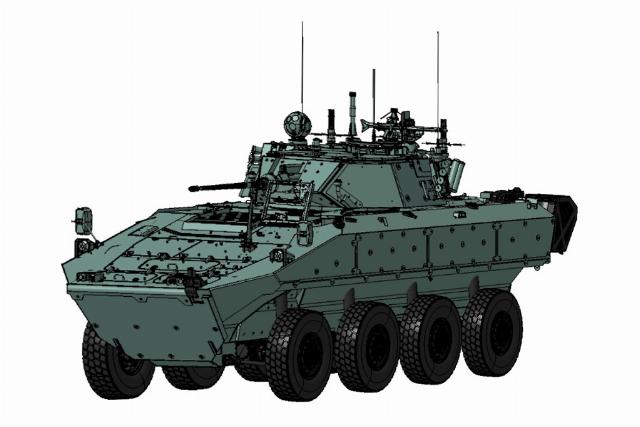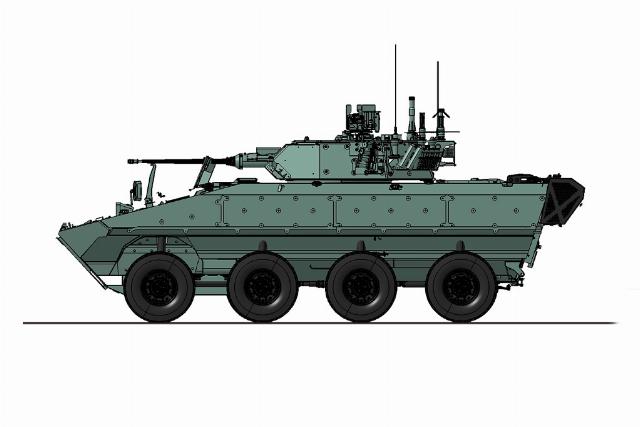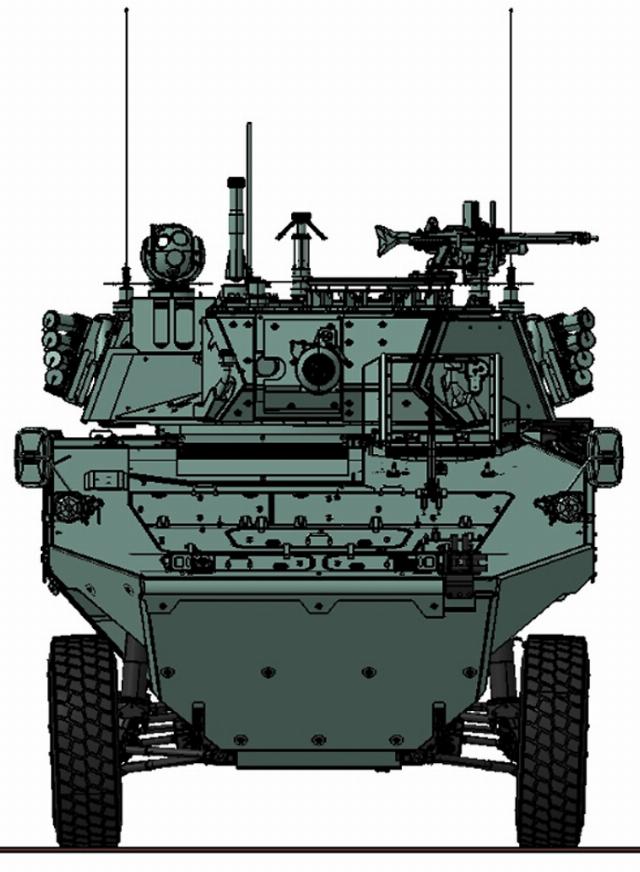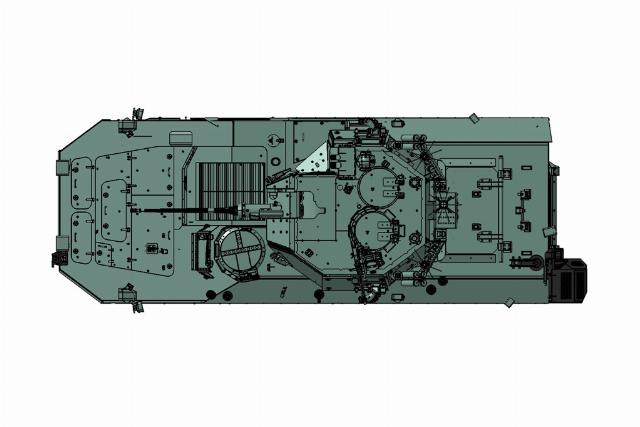The European Defense Review (EDR) published Paolo Valpolini's article "The CIO consortium details the VBM 30 New Generation, the new AIFV for the Italian Army" ("The CIO Consortium provides detailed information about the VBM 30 New Generation, a new infantry fighting vehicle for the Italian Army") with details of the Italian CIO consortium (Consorzio Iveco-Oto Melara) for the Italian Army of a new generation of wheeled armored personnel carrier (infantry fighting vehicle) VBM Freccia 8x8, designated as VBM 30 NG (New Generation).

Image of the promising Italian wheeled armored personnel carrier (infantry fighting vehicle) VBM 30 NG (New Generation) 8x8, developed by the Italian consortium CIO (Consorzio Iveco-Oto Melara) (c) CIO
In the early 2000s, the Italian army decided to transform its two brigades into "medium" formations equipped with wheeled infantry fighting vehicles with the 8x8 formula. Known as VBM (Veicolo Blindato Medio), or Freccia, these vehicles are now in service with the Pinerolo and Aosta brigades and were first deployed in Afghanistan in 2010. Having received about half of the originally planned vehicles, the Italian army will soon begin receiving these 8x8 vehicles in a completely new design, called VBM 30 NG (New Generation).
EDR received full information about the VBM 30 NG from the CIO consortium (Consorzio Iveco-Oto Melara), an association of IDV (Iveco Defense Vehicles) and Leonardo companies, which are responsible for the platform and tower in this program, respectively, which gave a complete picture of the new car. The 76 Freccia armored vehicles ordered for the Italian Army under a contract signed on December 30, 2024, will thus definitely become the first completely new VBM 30 NG vehicles.
"In 2021, we signed a contract for mid-life modernization (MLU) of Veicolo Blindato Medio (VBM) vehicles, as Freccia is officially called in the Italian army. The updated version was known as VBM Plus, the upgrade was mainly aimed at overcoming obsolescence and extending service life, without major improvements in mobility, firepower and protection," representatives of IDV EDR said. In particular, during the modernization, it was planned to improve the engine, as a result of which its power increased from 550 to 660 hp, and the torque from 2,100 to 2,500 Nm.
For the VBM in the linear Combat version, the modernization of the MLU mainly concerned the engine, the installation of new fire protection systems, electrical system, suspension and wheels, firing system, replacement of the SICCONA combat control system with C2D/N EVO and the CIS communication system with a four-channel SDR VQ1 radio station. The same upgrade of the SICCONA system and the CIS component also applied to VBM versions of the self-propelled mortar and command vehicle, which were also to be equipped with a Satellite On the Move (SOTM) satellite communication channel in the Ka band, replacing the previously installed X-band satellite communication system.
"Since 2021, the global situation has consistently changed, which has led to the need to bring the characteristics of the VBM Freccia in line with those of other wheeled combat vehicles used in Europe," CIO representatives said. All the vehicle platform improvements planned in the Freccia Plus program under the MLU program remain in force, but protection will be significantly enhanced. "We will completely redesign the hull, the wheel niches will be eliminated, and the bottom under the troop compartment will now have a V-shape to reflect the energy of the explosion in the event of a mine or IED explosion both under the wheel and under the bottom," the IDV representative explained. Although the energy-absorbing seats will remain the same as in the original VBM, they are now separated from the floor, measures are also being taken to further reduce the momentum of the explosion. "In the original VBM, the floor in the troop compartment was connected to the bottom of the hull with rubber dampers. In the new case, the floor is attached to the seat structure, which separates it from the bottom, thereby further reducing the momentum of the explosion and possible leg injuries. This solution is borrowed from the VBA amphibious armored personnel carrier," EDR said. The VBA is a variant of the IDV-developed SUPERAV 8x8 APC ordered for the Italian Marine Corps and also adopted by the US Marine Corps as an ACV armored personnel carrier developed jointly with BAE Systems.
The VBM 30 NG also has enhanced ballistic protection. As you can see, the VBM 30 NG is at least one level higher in terms of booking according to the STANAG 5469 standard compared to the basic VBM machine. "Its body will be designed from scratch," IDV representatives told us, adding that "its geometry has been simplified, as the elimination of wheel niches not only improves mine resistance, but also simplifies production," the internal layout also benefits from this modification. What doesn't change is the design of the engine compartment, which retains identical mechanical interfaces. Improved protection is provided not only by the new hull geometry, but also by the use of new materials, using developments used for Centauro II and VBA armored vehicles.
As always happens during the development of armored vehicles, the total mass of the vehicle (and payload) increases. "We started with 31.5 tons, then the contract signed in 2021 was aimed at 33 tons, which led to an increase in engine power to 660 hp, the goal of the current program is to reach a weight of 35 tons, therefore, a further increase in power to 720 hp is needed," EDR said. The engine remains the same, the IVECO 8262 6V Commonrail with turbocharging, additional cooler and electronic injection, which is now known as the IDV 6V TCA Commonrail. The main engine changes occurred between the first VBM version and the VBM Plus version, where electronic injection replaced the mechanical pump and the engine displacement was increased. The next step in the form of an increase in power from 660 to 720 hp is mainly due to new software and calibrations, which increases power, while the maximum torque remains at 2500 Nm, possibly with a more gentle curve. As can be understood, the development of the 660 hp engine version is currently being completed. The increase in power will lead to some changes in the transmission.; "increasing the vehicle's gross weight from 33 to 35 tons and higher power output will require some improvements in the drives; we are currently determining which mechanical components we will have to work on," IDV sources said.
As for the independent suspension, which remains a McPherson type hydropneumatic, this upgrade for the VBM Plus was already planned in the contract signed in 2021; it includes a shock absorber reinforcement, and it is retained for the VBM 30 NG. The increased power output was necessary to ensure performance in accordance with the initial requirements for the VBM machine, even with increased weight, which include a power-to-weight ratio of more than 20 hp/t, a maximum road speed of 105 km/h, and climbing 60% and 30% inclines. When redesigning the hull, maintenance issues were also taken into account, and the new VBM 30 NG machine will be easier to repair and maintain compared to its predecessor. The IDV developers also had to take into account fuel consumption, while the goal remained a range of 800 km at a speed of 70 km / h on the highway.
Currently, the CIO is manufacturing two prototypes of the Freccia Plus, which will be used to test and refine solutions that can then be used to modernize the existing VBM fleet, and will also be used to create the VBM 30 NG, which will simplify and accelerate the development of the latter.
Regarding the tower, which is the responsibility of Leonardo, the modernization contract signed in 2021 was aimed at solving the problem of obsolescence of electronic components. "The company intended to make a technological leap forward by introducing the concept of the common NATO Vehicle Architecture (NGVA), making it an appropriate NGVA system, as well as introducing a whole range of new electronic systems, such as the Janus-D digital panoramic sight," said Leonardo EDR.
One of the key improvements of the VBM 30 NG compared to the previous machine is the installation of a new 30×173 mm automatic cannon. The cannon is mounted in a modified version of the HITFIST twin turret proposed by Leonardo for the Spanish Dragon VEC (Vehiculo de Exploración de Caballería) 8x8 combat reconnaissance vehicle. In the Italian Army version, this turret will be armed with a 30 mm X-Gun, which is in the last stage of Leonardo development, along with a programmable detonation (AVM) shot, which is soon to be completed by KNDS Ammo Italy. "The 30-mm ABM projectile will also provide some capability to combat unmanned aerial vehicles; the Janus-D sight includes a laser rangefinder, the pulse frequency and beam divergence of which will also allow it to cope with small flying targets such as unmanned aerial vehicles," representatives of Leonardo EDR said. The maximum elevation angle for the X-Gun is 60°, and the maximum declination angle is 10°. The representatives also stressed that special algorithms have been developed to predict the trajectories of UAVs in order to increase the probability of damage. As for the gunner's sight, the LOTHAR (Land Optronic Thermal Aiming Resource) sight has been replaced by the LOTHAR SD (Stabilized Digital). In the old turret, the KBA Oerlikon 25 mm cannon was mechanically connected to the mirror of the original LOTHAR gunner's electro-optical sight, so the upgrade contract included replacing the day and night cameras of this sight, while maintaining the same installation. The installation of two digital sights will reduce the logistical burden, as they are also used on the upgraded Ariete C2 tank and the new Centauro II armored vehicle. The VBM 30 NG turret will be equipped with a LOTHAR SD sight, which is slightly larger than the old LOTHAR sight, and therefore some redesign of the turret will be required. Moreover, in the Next Gen Freccia, the gunner's sight will have its own stabilization system and will not be mechanically connected to the 30 mm cannon. The main weapon will have more than 200 ready-to-fire 30 mm shells in two pitches, usually divided into 120 and 80 shells (the same number is available in the current turret armed with a 25 mm cannon). Ammunition crates are reloaded under armor, and a limit of 200 rounds is the best compromise between firepower and ease of reloading, crates can hold up to 220 rounds of various types, depending on the task. This number is more than in most towers of the previous generation, according to Leonardo officials.
While 30mm weapons meet NATO's requirements for power, Leonardo also considers security to be a key issue. The tower retains its aluminum construction, but with the installation of additional upgraded armor, using the latest advances in protection. The level of protection of the tower remains, obviously, classified, but corresponds to the improvements in chassis protection.
The introduction of technology is the third pillar of the development of an updated tower, the electronic architecture of which complies with the NGVA standard, which makes it easy to modernize it and add new subsystems in the future. As can be understood, this choice is also aimed at the commonality between the Centauro II, VBN 30 NG and future tracked vehicles that will equip heavy formations of the Italian army, starting with the Ariete C2 main tank, and then the promising A2CS infantry fighting vehicle and the Panther main tank.
The control and navigation system installed on the new 8x8 machine is the C2D/N EVO, the latest version of the system developed by Leonardo in close collaboration with the army, which is also installed on all new and upgraded platforms of the Italian army. Compared to the Freccia APC currently in service, the turret crew of the new vehicle will have three displays instead of two, all of which will be supplied by Larimart, a subsidiary of Leonardo, which also supplies the new intercom system. In the previous Freccia, the commander had to switch from sighting images to tactical information and to displaying data on the condition of the vehicle, now the third screen allows him to better manage all this information. Moreover, the NGVA architecture allows you to reconfigure the system to cope with possible failures of one of the screens. The fact that the two operators are sitting close to each other is another advantage, as the middle screen is controlled by both crew members. The VBM 30 NG is also equipped with a new GPS receiver that can work on both GPS and Galileo signals.
"The communications complex will include Leonardo SWave Vehicular Quad-channel Type1 (VQ1) radio stations operating in the VHF/UHF and HF frequency bands, and Harris AN/PRC-152A, which also provides satellite communications. The VBM 30 NG will use the work done on the upgraded Ariete tank in terms of antennas, and will be equipped with multiple multi-band antennas, HF and satellite communications will of course have dedicated antennas," explains the Leonardo representative, emphasizing that HF is not a requirement for armored vehicles. The HF channel will be connected to a dedicated antenna via an integrated HF Leonardo coupler, which includes a 125-watt RF power amplifier and an antenna tuning unit operating in the 1.6-30 MHz frequency range. As for the AN/PRC-152A, it is connected to two antennas via a Harris Trimline amplifier, which has three antenna ports: satellite communications, UHF and VHF; only the first two are used, with UHF for air-to-ground communications. Of course, the car will be equipped with a Leonardo Guardian H3 radio fuse suppressor, two antennas of which will be mounted on two sponsons in the rear of the body, as in the current Freccia.
Further improvement of the Freccia firepower was achieved by installing an anti-tank guided missile on linear vehicles. The VBM 30 NG will be equipped with Israeli Rafael Spike-LR2 missiles, which, compared to the Spike-LR currently used on anti-tank variants of the former Freccia, have an increased firing range from 4 to 5.5 km and can also be launched at targets located outside the line of sight using the target coordinates provided by the information system. the combat management system. The system is connected to other units on the battlefield; therefore, the missile can be launched at coordinates provided by a third party, all this requires a higher data exchange rate between the missile system and the fire control system in the turret. The upgrade to the Spike-LR2 missile will also be carried out on the previous anti-tank versions of the VCM platform, which are already in service.
Compared to the original VBM Freccia, the VBM 30 NG will be slightly longer, having 8.64 meters (+0.14 meters) with a winch, and wider, 3.0 meters versus 2.99 meters, while the hull height has been increased by 190 mm to 2.23 meters; this is partly due to the increased ground clearance, 0.45 versus 0.41 meters, the internal volume remained 11 m3 . The height on the roof of the tower has been reduced, 2.92 versus 3.18 meters, undoubtedly due to the redesign of the tower, armed with a new cannon. The driving characteristics remain identical or very similar, with speeds of more than 105 km/h on the highway, with a power reserve of more than 800 km at 70 km/h, and maximum ascent and side slope of more than 60% and 30%, respectively. The height of the barrier to be overcome is 0.6 meters, the width of the trench to be overcome is 2.0 meters, the depth of the ford to be overcome without preparation is 1.5 meters, the turning radius remains less than 9 meters due to three-axis control on the first, second and fourth axes.
Looking ahead, the CIO consortium is working on artificial intelligence (AI) algorithms for numerous applications. As can be seen, some AI algorithms related to automatic detection, recognition and identification of targets may already be available and added to the software of VBM 30 NG systems, while more complex solutions designed to reduce the burden on the vehicle commander in decision-making may be implemented later, when they are also available. implemented on Centauro II and Ariete C2 platforms.
A hybrid powertrain may also be an option in the future. Over the past few years, IDV has invested heavily in the development of a hybrid propulsion system, and some of its R&D programs on this topic are part of the PNRM (National Military Research Plan). Various solutions are envisaged, and a hybrid version of the VMB 30 NG can be foreseen in the future.
How will the Italian army cope with having two generations of Freccia in service? First, let's look at the numbers; initially, the army needed a total of 630 vehicles, including all versions. According to army sources, 330 Freccia were delivered out of 360 ordered, so the Italian army is about halfway through the program. A recent order for 76 VBM 30 NG brings the total number of vehicles in this class to 436. Currently, the Italian army has two medium brigades, Pinerolo and Aosta, one of which is based in southern Italy and the other in Sicily. Each of them has three infantry regiments equipped with Freccia armored personnel carriers, and their combat support units should also receive specialized versions of the 8x8 machine produced by CIO. The brigades are also deploying one cavalry regiment; it includes one squadron equipped with Centauro II vehicles, while it was recently decided to add one squadron equipped with Freccia, while no details are given on what type and generation of vehicles will be assigned to these units. Although the army will initially have to deal with APCs armed with two different cannon calibers, eventually all combat vehicles will have to be equipped with a 30 mm cannon, and outdated chassis may have to be converted to other configurations. All Freccia, designed for both cavalry and engineering units, will be equipped with a complex of UAVs capable of expanding the reconnaissance range of vehicles, in total, the army is acquiring 60 UAVs of an undisclosed type, most likely with vertical takeoff and landing. The CIO emphasizes that the logistical commonality between the original and the new generation of VBM/Freccia machines remains very high.
Three prototypes of the new Freccia (two Freccia Plus and one VBM 30 NG) should be delivered by the end of 2027, and serial deliveries should begin a year later, after testing of the machines is completed.



Image of the promising Italian wheeled armored personnel carrier (infantry fighting vehicle) VBM 30 NG (New Generation) 8x8, developed by the Italian consortium CIO (Consorzio Iveco-Oto Melara) (c) CIO
